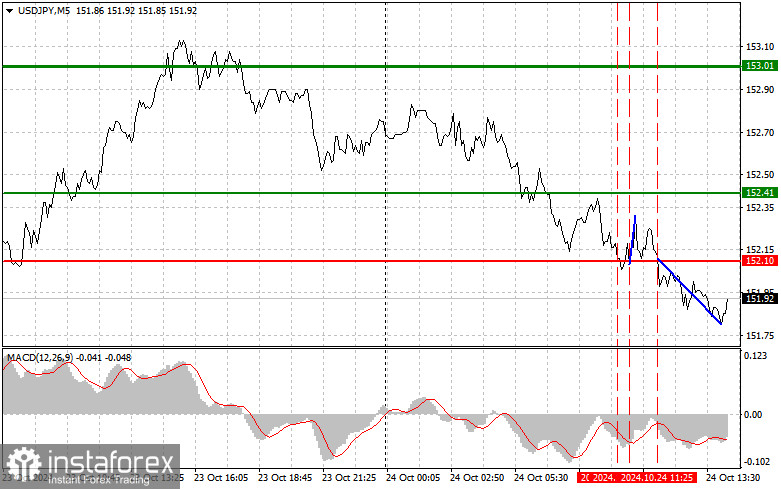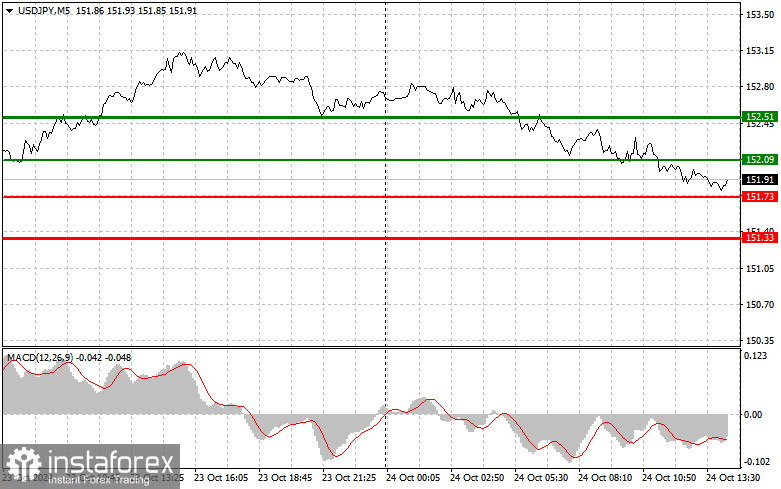Analysis of Trades and Tips for Trading the Japanese Yen
The test of the 152.10 price level coincided with the moment when the MACD indicator had fallen significantly below the zero line, which, in my opinion, limited the pair's downward potential. As a result, I decided not to sell. The second test of this price, with the MACD in the oversold zone, allowed Scenario #2 to play out, resulting in a 20-point rise in the pair. Only on the third attempt did the test of 152.10 coincide with the start of the MACD's downward movement from the zero line, enabling a dollar sell-off and a gain of around 30 points. Data on the U.S. Manufacturing and Services PMI indices will play a key role later in the day. Strong data could justify buying the dollar again, aiming for the continuation of the pair's uptrend following a substantial correction. As for the intraday strategy, I plan to focus on executing Scenarios #1 and #2.

Buy Signal
Scenario #1: Today, I plan to buy USD/JPY upon reaching the entry point around 152.09 (green line on the chart) with a target of rising to the 152.51 level (thicker green line on the chart). At 152.51, I plan to exit the buys and open sells in the opposite direction, aiming for a move of 30-35 points back from that level. A rise in the pair today is only feasible if U.S. data is strong. Important: Before buying, ensure that the MACD indicator is above the zero line and just beginning to rise.
Scenario #2: I also plan to buy USD/JPY today in case of two consecutive tests of the 151.73 price level when the MACD indicator is in the oversold zone. This will limit the pair's downward potential and lead to a market reversal upwards. A rise to the resistance levels of 152.09 and 152.51 can be expected.
Sell Signal
Scenario #1: I plan to sell USD/JPY after it breaks below the 151.73 level (red line on the chart). This break is expected to lead to a quick decline in the pair. The key target for sellers will be the 151.33 level, where I plan to exit the sales and immediately open purchases in the opposite direction, expecting a move of 20-25 points back from that level. Selling pressure on the pair will likely return if the data is weak. Important: Before selling, ensure that the MACD indicator is below the zero line and just beginning its decline.
Scenario #2: I also plan to sell USD/JPY today in case of two consecutive tests of the 152.09 price level when the MACD indicator is in the overbought zone. This will limit the pair's upward potential and lead to a market reversal downwards. A drop can be expected to the resistance levels of 151.73 and 151.33.

What's on the Chart:
- Thin green line: Entry price for buying the trading instrument.
- Thick green line: Approximate price where you can place a Take Profit or manually secure profits, as further growth above this level is unlikely.
- Thin red line: Entry price for selling the trading instrument.
- Thick red line: Approximate price where you can place a Take Profit or manually secure profits, as further declines below this level are unlikely.
- MACD Indicator: When entering the market, it is important to pay attention to overbought and oversold zones.
Important: Beginner traders in the forex market should be very cautious when making decisions to enter the market. It is best to stay out of the market before the release of significant fundamental reports to avoid getting caught in sharp price movements. If you decide to trade during news releases, always use stop-loss orders to minimize losses. Without stop-loss orders, you can quickly lose your entire deposit, especially if you do not use money management and trade large volumes.
Remember, successful trading requires a clear trading plan, like the example provided above. Making spontaneous trading decisions based on the current market situation is an inherently losing strategy for an intraday trader.
 English
English 
 Русский
Русский Bahasa Indonesia
Bahasa Indonesia Bahasa Malay
Bahasa Malay ไทย
ไทย Español
Español Deutsch
Deutsch Български
Български Français
Français Tiếng Việt
Tiếng Việt 中文
中文 বাংলা
বাংলা हिन्दी
हिन्दी Čeština
Čeština Українська
Українська Română
Română

